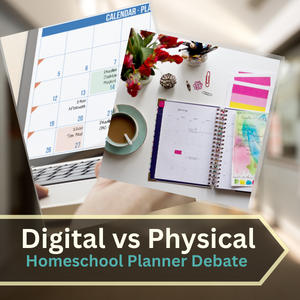Welcome to Happy Pages Homeschool, where your homeschooling journey transforms from daunting to delightful! As you enter this exciting phase, one crucial question often arises: Digital v Physical Homeschool Planner – which is better? Let’s dive into this digital v physical homeschool planner debate, exploring options that resonate with your unique homeschooling style as a homeschool mom.
What Makes a Good Homeschool Planner?
When considering a digital or physical homeschool planner, it’s essential to understand what makes a planner effective for managing your homeschool curriculum. A good homeschool planner should:
- Be user-friendly and accessible
- Allow customization to fit your family’s needs
- Provide space for tracking academic progress and daily activities
- Include features for scheduling, reminders, and links to printable resources.
Whether digital or physical, the right homeschool planner, full of printables and links, aligns with your lifestyle and teaching approach as a homeschool parent.
Paper Planners vs. Digital Planners: Pros and Cons
Digital Homeschool Planners:
Pros:
- Accessibility: Access your digital homeschool planner anytime, anywhere.
- Integration: Easily sync with other digital tools and calendars. The ease of digital resources is at your fingertips.
- Customization: Tailor and adjust your planner with a few clicks.
- Eco-friendly: Using digital homeschool planners and printables is a great way to be environmentally conscious. Reduce paper usage with a digital approach.
Cons:
- Dependence on Technology: Requires reliable internet and devices.
- Learning Curve: Some may find navigating digital tools challenging.
- Less Tactile: Lack of physical interaction can be a downside for some.
Physical Homeschool Planners:
Pros:
- Tactile Experience: Many appreciate the feel of writing in a physical planner.
- No Tech Required: Accessible without needing devices or internet.
- Visual Appeal: Often more aesthetically pleasing and personal.
- Simplicity: Straightforward, no need for technical know-how.
Cons:
- Less Flexible: Making changes can be messier and more time-consuming. It is more time-consuming to copy repeated information.
- Bulkier: Carrying a physical planner can be less convenient. Easier for it to be lost or damaged.
- Resource Intensive: More paper usage is less eco-friendly.
In the digital v physical homeschool planner debate, both have their unique advantages and drawbacks. It’s about finding what aligns best with your family’s needs.
How to Organize Your Homeschool Planner for Maximum Efficiency
The organization is critical for leaning towards a digital or physical homeschool planner. Here are some tips:
- Set Clear Goals: Define what you want to achieve with your planner.
- Regular Updates: Keep your planner up-to-date for maximum effectiveness.
- Involve Your Children: Make planning a collaborative effort for your lesson plans.
- Review Regularly: Adjust and tweak your plan as needed.
Remember, the best digital or physical homeschool planner is one that you use consistently and effectively.
Digital Homeschool Planners: What Are Your Options?
Exploring the digital side of the homeschool planner debate, there are numerous options available:
- App-Based Planners: These offer functionalities like reminders, syncing with other devices, and customizable templates.
- Online Platforms: Some websites offer comprehensive planning tools tailored for homeschoolers.
- Customizable Templates: Downloadable templates that you can adjust according to your needs.
The key is to choose a digital homeschool planner that feels intuitive and complements your teaching style.
Writing It Down: The Underrated Value of Paper Planners
Despite the rise of digital tools, the value of a physical homeschool planner remains significant. Writing things down can:
- Improve memory retention.
- Offer a break from screen time.
- Provide a more personal and hands-on approach to planning.
In the discussion on digital vs. physical homeschool planning, never underestimate the power of pen and paper!
Balancing Flexibility and Structure in Your Homeschool Plan
Balancing flexibility and structure is crucial in the digital v physical homeschool planner conversation. Whether you’re a digital planner enthusiast or a paper planner devotee, here’s how to strike that balance:
- Set a Flexible Routine: Use your planner to establish a routine adaptable to life’s unpredictabilities.
- Allow for spontaneity: Leave room in your planner for impromptu learning opportunities.
- Regularly Review Plans: Adapt and modify your plans as your family’s needs evolve.
The digital or physical homeschool planner you choose should support a blend of structure and spontaneity.
Tracking Progress: Digital Tools vs. Traditional Methods
Regarding tracking educational progress, the digital v physical homeschool planner debate gets interesting. Digital tools offer automated tracking and analytics, while traditional methods provide a more hands-on approach. Consider:
- Ease of Access: Digital planners often make it easier to review past data.
- Personal Touch: Physical planners can be more meaningful and engaging.
- Data Analysis: Digital planners can offer insights and trends over time.
Choose a digital or physical homeschool planner method that makes tracking progress straightforward and meaningful.
Incorporating Online Resources into Your Homeschooling Plan
Whether you lean towards a digital or physical homeschool planner, incorporating online resources is vital. Digital planners can seamlessly integrate these resources, while physical planners can include notes and references. This integration ensures a rich, diverse educational experience.
Customizing Your Planner: Tips for Both Digital and Paper Formats
Customization is key in deciding whether to use a digital or physical homeschool planner. Here’s how to tailor each to your needs:
- Digital Planners: Use digital features like color-coding, tagging, and integrating various apps.
- Paper Planners: Use stickers, colored pens, and tabs to make your planner more personal and organized.
Your planner should reflect your family’s unique homeschooling journey.
End of the Year Reflection: Assessing Your Homeschool Planner’s Effectiveness
As the homeschool year wraps up, reflect on whether digital or physical homeschool planners are effective. Ask yourself:
- Did the planner help you achieve your educational goals?
- How well did it adapt to your family’s changing needs?
- What would you change or keep for the next academic year?
This reflection will guide you in choosing the right digital or physical homeschool planner for the following year. Try digital and physical planners and find a system that works best for you.
Are you ready to choose between a digital or physical homeschool planner? Join our community at Happy Pages Homeschool for more insights, tips, and support on your homeschooling journey. Share your experiences and learn from fellow homeschooling moms as we navigate this exciting path together!




